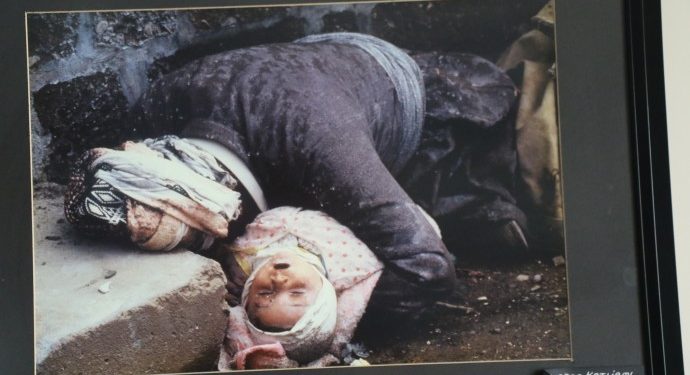CENTRAL NEWS
We are witnessing yet another anniversary of a massacre committed against the Kurds: Halabja. One of the most brutal massacres in the history of Kurdistan.
The calendars showed March of 1988. Beginning on the 16th and ending on the 18th, thousands of Kurds – including the women and the children, the beautiful nature of Kurdistan, and it’s animals were killed with the most unforgiving chemical weapon of our day. An attack that pushed the limits of brutality. A people who’s lives are written in blood and gunpowder were caught again by the ferocious grasp of death.
The movements and parties acting on behalf of the Kurds united with other states and turned to another colonial state and called for this massacre. Thousands of Kurds will be slaughtered, the so-called advanced white humanitarianism will not even make a move. It will remain in absolute silence. I, myself, would face this contradiction after living in Europe, 22 years ago.
And indeed this story is of the type to cry to because the chemical weapons falling on the Kurds are of European origin. This includes Germany, England, and the Netherlands as well as the entire western community of the world.
And what a pity it is that the Kurds still hope from the west. That the Kurds still look to the west, and that the West still does not shape its interests based on the snow-freezing human consciousness.
Now to look at the most brutal massacre, from now on, the most that can be taken out of such a disaster is a lesson. Understanding how to prevent such massacres, to weaken the possibility of massacres by foreseeing what might happen in the future, should be the most important lesson to be drawn from the Halabja massacre.
Before the Halabja massacre, that is, in the 1980s, the West, and especially the USA, backed Saddam and attacked the Iranian state. There had been a hot war between Iran and Iraq for 8 years. It was clear that hundreds of thousands of people would be massacred, the economies were a mess, and the imperialists needed a war to show off their new toys. A war that only the imperialists would win.
It would be politically cooperative and idiotic to carry out the wars of others, on behalf of others. In our age, we call it betrayal, some call it treachery.
While Iran and Iraq were at war, the Kurds would then resist against Saddam in the south. However, as seen in the case of PUK – and the entire history of Kurdistan; trying to fight like a mercenary by taking sides with other enemies, by taking their weapons instead of resisting has brought nothing but calamity.
History demands: If you are going to fight, you will fight for yourself.
If you are going to fight, you will fight based on your own strength and the strength of your people. History has shown us that when you do not do this and when you fight for someone’s interests, you will face all kinds of massacres.
The Halabja massacre is a massacre that took place in environments where such narrow, shallow and politically distant politics were implemented. The Halabja Massacre is part of the Operation Al-Enfal to suppress the rebellion of Kurds against Saddam Hussein in the north of Iraq in 1986-1988 during the Iran-Iraq War.
In the period when Saddam Hussein intensified the Operation Al-Enfal between February 23 and September 16, 1988, in mid-March, the Iranian army launched a general offensive called Operation Victory-7. Peshmerga affiliated with the Kurdistan Patriotic Union led by Celal Talabani also entered the town of Halabja in cooperation with the Iranian Army and rebelled. And Saddam Hussein ordered to use Lieutenant General Ali Hasan al-Majid al-Tikriti or ‘Chemical Ali’ nicknamed-poisonous gas bombs to stop the advance of the Iranian army.
On March 16, 1988, eight MIG-23 aircraft carrying toxic gas bombs bombarded to the town of Halabja. It was estimated that more than 5,000 people died and more than 10,000 people were injured in Halabja. However, it would be revealed later that this number was higher. The destruction it has created on people are still influential today. How long it will take is not yet predicted, til the effects of the chemicals wear off. It is unpredictable because till today the destruction it has created is still untouched.




